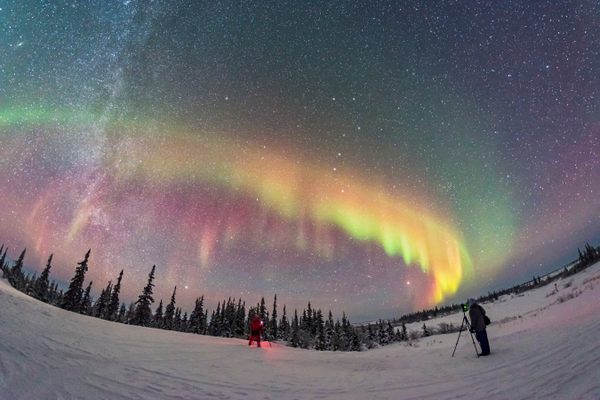How to Find 2018’s Brightest Comet
Seeing it for yourself will take some planning and effort.

The brightest comet to grace 2018 will curl over the sky this week as it inches closer to the Earth, leaving behind a barely perceptible tail. However, seeing it for yourself will take planning and effort, because although it’s the brightest, it’s still hard to see with the naked eye.
The Wirtanen Comet (or Comet 46P) may be the brightest comet of the year, but it’s still not all that bright. It looks like a “fuzzy blob in the sky,” according to Deborah Byrd, editor-in-chief of the EarthSky website. While it may not be as flashy as the gleaming planets or constellations in the December night sky, it is worth finding, says Byrd.
Comets are bits of space debris, flying time capsules of eons-old star stuff. Scientists believe they were formed at the birth of our solar system, over four billion years ago. They are sometimes referred to as “dirty snowballs,” because of their frozen centers and layers of dark organic material. They are some of the “small bodies” of our solar system, generally about the size of a small town. The Wirtanen Comet is 0.75 miles in diameter. “That’s a tiny little speck,” says Byrd. “It’s a piece of dust compared to a planet like Earth.”
The remarkable thing about Wirtanen is that on its closest pass on December 16, it will be only seven million miles from Earth. That’s basically close enough for a high five, in space terms. “Wirtanen Comet’s closeness is what allows us to see it,” says Byrd. Her website has already received dozens of photos from amateur astronomers from around the world who have spied the comet through their telescopes. There are images from Hong Kong, Namibia, Chile, and Australia, among others.

To see it for yourself, Byrd recommends finding a local astronomy club in your area, ideally in a place with little light pollution and a great dark view of the night sky. If you live in a city, or can’t bear the winter temperatures, the Virtual Telescope Project will have a live showing of the comet on December 12 and 16 at 10 p.m. UTC when it’s at its brightest.
If you do want to brave the cold, Byrd recommends trying to find the comet this week, with either a telescope or a pair of binoculars. A great time would be overnight, December 13 to 14, because then viewers can see the Geminid meteor shower along with the comet. Also, Byrd adds, the moon will be smaller this week, and less likely to outshine Wirtanen. If you stay out all night, you can admire Venus glowing in the predawn sky.
If you go out every night, you can track Wirtanen’s slow passage. “It doesn’t just whoosh across the sky,” says Byrd, “but from one night to the next, if you track it carefully, you will notice that it’s moving.” She says it will pass between the Pleiades and Hyades star clusters, which can be found on most maps of the night sky.
Comets have always been a wonder to humans. “They used to be considered omens of doom,” Byrd says. “Comets carry with them this sense of mystery at this sense of the unknown. They come and go. The fun thing about them is that they’re not here for very long. It’s an opportunity to go see something that maybe you’ve never seen before.”
Byrd wishes comet chasers well, but notes the most important thing to do is temper your expectations. “You’re not going to see this super bright, spectacular thing. It’s not like that,” she says. “You’re going to look up in this dark sky, and you’re going to spot it and you’re going to be really proud of yourself for seeing it. It’s a quiet beauty.”








Follow us on Twitter to get the latest on the world's hidden wonders.
Like us on Facebook to get the latest on the world's hidden wonders.
Follow us on Twitter Like us on Facebook